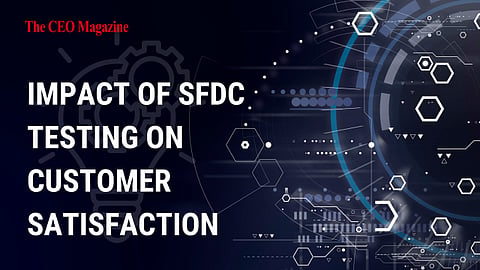
- News
- Women
- Magazine
- IndustryIndustry
- InsightsInsights
- Success Stories
- PublishPublish
- ContactContact
- Media KitMedia Kit

SFDC Testing
The value of robust software cannot be undermined in today's corporate operations, where technology plays a critical role in influencing consumer experiences. Salesforce, a major customer relationship management (CRM) software, has become essential for organizations looking to streamline procedures while enhancing client interactions.
Nevertheless, Salesforce's efficacy strongly depends on the accuracy of its implementation. As a result, Salesforce (SFDC) testing emerges as a vital component in assuring optimal performance.
Before digging into the impact, one must understand the different methodologies used in SFDC testing. Salesforce's Software Testing Life Cycle (STLC) is divided into various phases, each aimed to address a specific area of the software's operation or performance.
At the start of SFDC testing, a thorough analysis of requirements is essential. This includes comprehending the business processes and user stories the Salesforce deployment intends to address. The planning step outlines the testing approach, resource allocation, and timescales. A thorough grasp of company objectives ensures that testing produces the intended results.
The team develops comprehensive test cases based on the defined requirements during the test design phase. These test cases are intended to cover a variety of scenarios, assuring thorough coverage of Salesforce features. This step necessitates a thorough grasp of the Salesforce environment and the precise adaptations to meet the business goals.
The real testing procedure occurs during the test execution phase. Testers run the previously specified test cases, methodically examining every feature of the Salesforce application. This phase entails finding and recording flaws, allowing for their correction before the system goes live. Automated testing solutions can help improve efficiency, especially when repetitive testing is necessary.
Any flaws or abnormalities discovered during the test execution phase are reported and monitored systematically. This phase guarantees the development team has thorough information about the difficulties, allowing for a targeted and efficient resolution procedure. Effective communication between the testing and development teams is essential during this phase to guarantee a smooth operation.
One of the most important components of Salesforce testing is ensuring the quality and security of the data in the CRM system. Inaccurate data can cause poor company decisions and damage consumer confidence. SFDC testing assures the reliability of information stored on the Salesforce platform by thoroughly checking data integrity. Furthermore, effective testing processes aid in detecting and correcting security flaws protecting sensitive customer data from future breaches.
Customer happiness is directly tied to the Salesforce system's performance. Slow response times, system downtimes, and malfunctions can all harm user productivity and the overall customer experience. Performance bottlenecks can be found and fixed during thorough testing before they emerge in the actual environment. This proactive approach to system optimization immediately improves customer satisfaction by delivering a smooth and efficient user experience.
SFDC testing is critical in determining the user experience inside the Salesforce platform. Testing teams may thoroughly test user interfaces, processes, and integrations to detect and resolve any issues that may hamper user efficiency. A great user experience not only promotes user pleasure but it also adds to increasing Salesforce platform adoption, compounding its influence on overall company operations.
Downtime in Salesforce operations may have far-reaching repercussions, affecting internal processes and external customer interactions. SFDC testing, particularly regression testing and UAT, guarantees that no upgrades or modifications impair the system's regular operation. This careful testing reduces downtime, allowing organizations to constantly deliver uninterrupted services to their clients, thus increasing customer happiness.
Salesforce must frequently interface smoothly with other company platforms in today's electronically integrated world. SFDC testing includes rigorous integration testing to verify that data flows seamlessly between Salesforce and other applications. For organizations looking to facilitate these integrations efficiently, implementing salesforce ETL processes can ensure that data is extracted, transformed, and loaded effectively across systems.
Successful integration testing not only eliminates data silos but also helps to provide a comprehensive perspective of client interactions. This, in turn, allows for a more educated and responsive approach to client involvement, which ultimately influences satisfaction favorably.
Customer satisfaction relies heavily on the alignment of Salesforce functionality with business needs. SFDC testing, which starts with requirement research and continues through UAT, guarantees that the Salesforce deployment fits the organization's unique needs. Any deviations from the criteria are found and corrected throughout the testing phase, ensuring that the finished product is designed to streamline business operations and, as a result, improve customer satisfaction.
The influence of SFDC testing on customer satisfaction is significant and multifaceted. From verifying data correctness and security to optimizing system speed and improving user experience, each aspect of the testing process adds to Salesforce's overall dependability and efficiency. Businesses that emphasize SFDC testing reduce the risks associated with software faults and create a climate in which customer happiness is a natural outcome of effective software deployment.
Follow us on Google News
